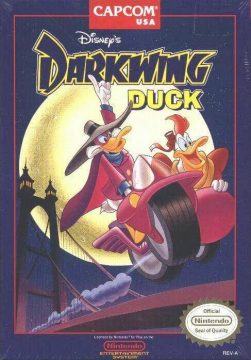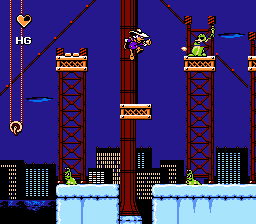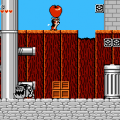- Darkwing Duck
Drake Mallard, average citizen by day and crime fighting Darkwing at night, acts as St. Canard’s heroic vigilante. Upon learning of the criminal organization F.O.W.L’s intention of taking over the city, Darkwing rushes to the scene, intent on foiling F.O.W.L.
Capcom’s NES rendition of Darkwing Duck is pretty straightforward – it’s basically Mega Man with some new graphics and some gameplay tweaks. You’ll find similarities in the level design and even some enemies, like caped ducks who act almost exactly like Sniper Joe from the Mega Man games, hiding behind a shield and only lowering it to attack. You can even choose the order to tackle the levels, although there’s only six versus the usual eight. You need to beat the first set of three before moving onto the second. The final level is also only a single stage. Many of the levels have hooks you can jump on, which also act as switches for certain platforms. You can also press Up to block certain projectiles, and, unlike Mega Man, Darkwing can actually duck! The end level bad guys, including Quackerjack, Megavolt, Bushroot, Moliarty, Liquidator, Wolfduck, and Steelbeak, are also a bit more involving than the usual Mega Man boss fights, usually mixing some platforming elements.
There are some annoying quirks though. For some reason, Darkwing can’t move while firing, resulting in situations where you’re pinned down by multiple enemies, when you should just be able to blast through them. You can’t fire when you use your cape, leading to many situations where you try to shoot but won’t, usually when you’re jumping. The controls just don’t feel as precise as they should. Cheap enemy placement is also an issue. Many enemies will suddenly appear off screen after completing a tough jump and plow into you. Your life meter is also pretty limited, as you can only take four hits, but at least life power-ups are common.
Many of the powerups are hardly useful. Darkwing can collect canisters of gas, each with their own abilities. Some produce arrows that can be used as makeshift platforms, while others create bullets that travel along the ground. While the arrow would normally be useful, it eats up a lot of ammo. Many areas that require use of the arrow allow for very little error, so if you screw up the placement once or twice you’re out of luck. The ground gas is of very limited use, as it’s often easier to just crouch down and shoot enemies that require it.
The graphics are passable. The enemies are fairly detailed and the backgrounds look nice, but considering this is a late generation NES title, they’re nothing to write home about. The sound effects, on the other hand, are terrible. Dialogue creates awful screeching beeps-the kind often found in low-budget unlicensed games. All the other sound effects, from shooting, getting hit, grappling, and dying, are quite dull. At least the music is quality Capcom. The music was composed by Yasuaki “Bun Bun” Fujita, also the primary composer of Mega Man 3.
Darkwing Duck is technically a fairly solid game, and it’s still enjoyable, but one just can’t help but shake the feeling that you’re just playing Mega Man, except not quite as good. As far as clones go, at least it’s better than The Krion Conquest. This game was only released in North America and Europe.
Like DuckTales, a beta version of Darkwing Duck was released on the internet. Much of the game is the same, save for a few minor differences later on in the game. The Moliarity boss fight starts off with all three flamethrowers active, unlike the final where one is broken. Moliarty only hurls hammers while he’s fixing the flamethrowers in the beta, whereas he only chucks them when all the flamethrowers are active in the final. Megavolt, the boss of the wharf level, is twice as fast in the beta, and he also doesn’t fire a ball of lightning on the floor as he does in the final.
Several graphical changes were made as well. The backgrounds for the bonus stages were changed between versions, and F.O.W.L. was fingered as the thieves in the first bonus stage in the beta. The hawks in the forest stage were previously owls in the beta. The lights on Steelbeak’s canopy were not present in the beta version, either. The platforms in the wharf level had spikes on top of them in the beta, and you could also hang on them. They were changed to slabs of stone in the final. Strangely, Darkwing’s gas gun bullets were changed in the final to appear more like fireballs than gas clouds.
The Game Boy version of Darkwing Duck is the final port of the NES Disney games, and is nearly identical to the console. Despite the obvious color degradation, the graphics are nearly the same, experiencing slight changes to the sprites and loss of background detail. The music is practically the same, and the dialogue sound effect was entirely changed, mercifully. The cheap enemy placement has also been removed, and in some cases the positions of enemies have been shuffled around. The stages have been condensed, which makes for a more action-packed game. The NES version had a number of areas full of dead space, so this small revision makes the game a little more enjoyable.
Jumping is more difficult than in the original. Unlike the NES game, if the jump button is released, Darkwing immediately plummets to the ground. While it’s not difficult to just hold the jump button, it can be confusing to those used to the console version. The height of Darkwing’s jumps has also been reduced, most likely because of the lower screen size. Some platforming sections are more difficult because of this, often requiring you to get to the absolute edge of a platform before jumping. Also, in the NES version, you couldn’t fire if you put up your cape. This was fixed in the Gameboy version. Despite some of these problems, the port is superior to the console version in some cases. Once again, however, there’s no huge reason to play the Game Boy version over the NES today.
Screenshot Comparisons
Other Versions: Darkwing Duck – TurboGrafx-16 (1990)
If you thought the TG-16 version of Talespin was bad, you haven’t seen anything. Darkwing Duck is yet another one of very few North American exclusive titles for the system, and was developed by Interactive Designs. It’s another tragically bad sidescrolling shooter, with extremely poor level design and generally glitch programming. Much like the NES game, you can choose from a variety of villains to fight, including Megavolt, Tuskerninni, and Moliarty, before going up against Steelbeak. The problem is, you have extremely limited ammo. As in, each ammo pick-up gives you only a few shots. Furthermore, these don’t even kill enemies – even though each gas pellet is supposed to have different effects, they don’t appear to do much of anything. You’re supposed to jump on their heads, but that rarely works in practice. As a result, you’re usually defenseless through each terribly constructed, poorly programmed level. The sprites are pretty decent, when they’re not in motion, but that’s the only positive of this huge trainwreck.




